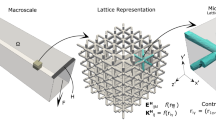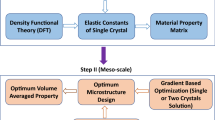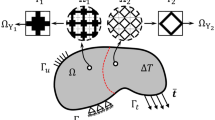Abstract
This paper introduces procedural generation of lattice structures inside predefined volumes for fatigue life enhancement of multiscale constructed structural components. Global optimization is applied to search the design space such that the mass and fatigue damage is minimized given the orientation of the microscopic lattice unit cells and the volume fraction of lattice material. A two-step optimization procedure is applied to avoid local minima. The macro-scale distribution of homogenized lattice material is first determined using a design search method. The second stage employs global optimization with surrogate modeling. Training data is initialized by hypercube sampling to fit a surrogate model so that a genetic algorithm can locate the global minima of the global design space using the lattice rotation and solid volume fraction. New results are applied to the procedural methods to create new testable models which optimize the microscale for minimum mass. New data points are used to enrich the surrogate model database and the model is rebuilt. The procedure iterates until a convergence criterion is met. A case study is presented to demonstrate the proposed methodology to which the mass was reduced by 87%, while fatigue performance was conserved for long life cycles of 106. A comparison between lattice modeled with linear beam elements versus lattice material as a three-dimensional solid is presented to validate the optimal solution. It is found that stresses were underestimated by at most a factor of four, while the difference in deflections was maintained within 8.1%.


























Similar content being viewed by others
Availability of data and materials
The data presented in this study are available on request from the corresponding author.
Code availability
N/A.
References
Allaire G (1997) The homogenization method for topology and shape optimization. Springer, Vienna
Bendsøe MP, Sigmund O (1989) Optimal shape design as a material distribution problem. Struct Optimiz 1:193–202
Bendsoe MP, Sigmund O (1999) Topology optimization: theory, methods and applications. Springer, New York
Buhmann MD (2003) Radial basis functions: theory and implementations. The Press Syndicate of the University of Cambridge, Cambridge
Deb K, Pratap A, Agarwal S, Meyarivan T (2002) A fast and elitist multiobjective genetic algorithm: NSGA-II. IEEE Trans Evol Comput 6(2):182–197
Fang Q (2018) Iso2Mesh. (MATLAB File Echange). Retrieved April 21, 2020, from https://www.mathworks.com/matlabcentral/fileexchange/68258-iso2mesh/
Hassani B, Hinton E (1999) Homogenization theory for media with periodic structure. In: Homogenization and structural topology optimization. Springer, London
Holmberg E, Torstenfelt B, Klarbring A (2013) Stress constrained topology optimization. Struct Multidiscip Optim 48(1):33–47
Horstemeyer MF (2009) Multiscale modeling: a review. Practical aspects of computational chemistry. Springer, New York, pp 87–135
Hussein A, Hao L, Yan C, Everson R, Young P (2013) Advanced lattice support structures for metal additive manufacturing. J Mater Process Technol 213(7):1019–1026
Huynh L, Rotella J, Sangrid MD (2016) Fatigue behavior of IN718 microtrusses produced via additive manufacturing. Mater Des 105:278–289
Kmiecik S, Gront D, Kolinski M, Wieteska L, Dawid AE, Kolinski A (2016) Coarse-grained protein models and their applications. Chem Rev 116(14):7898–7936
Krishna Dasari AS, Chaddad PA (2019) Random forest surrogate models to support design space exploration in aerospace use-case. In: Artificial intelligence applications and innovations (AIAI 2019), pp 532–544
Lebel LL, Therriault D (2011) Multiscale manufacturing of three-dimensional polymer-based nanocomposite structures. In: Advances in diverse industrial applications of nanocomposites, pp 409–428.
Lee J-Y, An J, Chua CK (2017) Fundamentals and applications of 3D printing for novel materials. Appl Mater Today 7:120–133
Li Z, Liu C, Wang B, Wang Z, Yang F, Gao C, Qin Y et al (2018) Heat treatment effect on the mechanical properties, roughness and bone ingrowth capacity of 3D printing porous titanium alloy. R Soc Chem 8:12471–12483
Li D, Dai N, Tang Y, Dong G, Zhao YF (2019) Design and optimization of graded cellular structures with triply periodic level surface-based topological shapes. J Mech Design. https://doi.org/10.1115/1.4042617
Lopes E, Cremasco A, Afonso C, Caram R (2011) Effects of double aging heat treatment on the microstructure, Vickers hardness and elastic modulus of Ti–Nb alloys. Mater Charact 62(7):673–680
Lucia A, DiMaggio PA (2004) Multi-scale optimization. Eur Symp Comput Aided Process Eng 14:1093–1098
Manu (2015) Patch Remesher. (MATLAB Central File Exhange). Retrieved April 21, 2020, from https://www.mathworks.com/matlabcentral/fileexchange/49691-patch-remesher
Moravec F, Roman S (2009) Numerical computing of elastic homogenized coefficients for periodic fibrous tissue. Appl Comput Mech 3:141–152
Pasini D, Moussa A, Rahimizadeh A (2018) Stress-constrained topology optimization for lattice materials. In: Altenbach H, Öchsner A (eds) Encyclopedia of Continuum Mechanics. Springer, Berlin, Heidelberg
Pincus M (1970) Letter to the Editor—A Monte Carlo method for the approximate solution of certain types of constrained optimization problems. Oper Res 18(6):1225–1228
Ruschau JJ, John R, Thompson SR, Nicholas T (1999) Fatigue crack nucleation and growth rate behavior of laser shock peened titanium. Int J Fatigue 21(1):S199–S209
Skala V (2016) A practical use of radial basis functions interpolation and approximation. Investig Oper 37(2):137–145
Spiga E, Degiacomi MT, Peraro MD (2014) Chapter Three—New strategies for integrative dynamic modeling of macromolecular assembly. Adv Protein Chem Struct Biol 96:77–111
Trudel E, ElSayed M (2021) Conformal wireframe nets for trimmed symmetric unit cells in functionally graded lattice materials. Appl Mech 2:81–107
Walker P, Malz S, Trudel E, ElSayed M, Kok L (2019) Effects of ultrasonic impact treatment on the stress-controlled fatigue performance of additively manufactured DMLS Ti-6Al-4V alloy. Appl Sci 9(22):4787
Wang Y, Xu H, Pasini D (2017) Multiscale isogeometric topology optimization for lattice materials. Comput Methods Appl Mech Eng 316:568–585
Wang C, Zhu J, Wu M, Hou J, Zhou H, Meng L, Zhang W et al (2021) Multi-scale design and optimization for solid-lattice hybrid structures and their application to aerospace vehicle components. Chin J Aeronaut 34(5):386–398
Xia L (2016) Multiscale structural topology optimization, 1st edn. ISTE Press-Elsevier, London
Yang X, Xie Y, Steven G, Querin O (1999) Bidirectional evolutionary method for stiffness optimization method. Struct Multidiscipl Optim 37:430–438
Yuan J, Li YM, Liu CL, Zha XF (2010) Leave-One-Out cross-validation based model selection for manifold regularization. In: Zhang L, Lu BL, Kwok J (eds) Advances in Neural Networks - ISNN 2010. ISNN 2010. Lecture Notes in Computer Science, vol 6063. Springer, Berlin, Heidelberg
Zeng Q, Yu A, Lu G (2008) Multiscale modeling and simulation of polymer nanocomposites. Prog Polym Sci 33(2):191–269
Zuo ZH, Huang X, Rong JH, Xie MY (2013) Multi-scale design of composite materials and structures for maximum natural frequencies. Mater Des 51:1023–1034
Acknowledgements
This work is carried out with the support from BOMBARDIER INC. Montreal, in collaboration with CARIC National Forum and MITACS Canada.
Funding
This research was funded by BOMBARDIER INC., in collaboration with CARIC National Forum, grant number MDO-1601 TRL4+ and MITACS Canada, Grant number IT07461.
Author information
Authors and Affiliations
Contributions
Conceptualization, MSAE; methodology, ET and MSAE; software, ET; validation, ET and MSAE; formal analysis, ET; investigation, ET; resources, MSAE; data curation, ET; writing—original draft preparation, ET; writing—review and editing, MSAE; visualization, ET; supervision, MSAE; project administration, MSAE; funding acquisition, MSAE.
Corresponding author
Ethics declarations
Conflict of interest
The authors hereby declare no conflicting interests.
Ethics approval
N/A.
Consent to participate
N/A.
Consent for publication
All authors have approved the content of this manuscript for submission and the manuscript is not under consideration for publication elsewhere.
Additional information
Publisher's Note
Springer Nature remains neutral with regard to jurisdictional claims in published maps and institutional affiliations.
Appendices
Appendix
A: Cubic lattice properties
Cubic lattice relative properties (Poisson ratio = 0.3) | ||||||
|---|---|---|---|---|---|---|
Density | Radius | D/L | 1st lame | 2nd lame | Poisson ratio | Modulus |
0.00E+ 00 | 0.00E+00 | 0.00E+00 | 0.00E+00 | 0.00E+00 | 1.53E+00 | 0.00E+00 |
4.67E−03 | 2.00E−02 | 4.00E−02 | 3.06E−05 | 4.11E−06 | 1.53E+00 | 4.61E−06 |
1.37E−02 | 4.00E−02 | 8.00E−02 | 1.66E−04 | 3.65E−05 | 1.45E+00 | 4.03E−05 |
3.55E−02 | 6.00E−02 | 1.20E−01 | 7.45E−04 | 2.58E−04 | 1.35E+00 | 2.79E−04 |
5.63E−02 | 8.00E−02 | 1.60E−01 | 1.62E−03 | 7.20E−04 | 1.29E+00 | 7.68E−04 |
8.44E−02 | 1.00E−01 | 2.00E−01 | 3.19E−03 | 1.79E−03 | 1.21E+00 | 1.87E−03 |
1.15E−01 | 1.20E−01 | 2.40E−01 | 5.47E−03 | 3.67E−03 | 1.15E+00 | 3.80E−03 |
1.55E−01 | 1.40E−01 | 2.80E−01 | 9.47E−03 | 7.61E−03 | 1.09E+00 | 7.76E−03 |
2.01E−01 | 1.60E−01 | 3.20E−01 | 1.51E−02 | 1.40E−02 | 1.03E+00 | 1.41E−02 |
2.40E−01 | 1.80E−01 | 3.60E−01 | 2.14E−02 | 2.22E−02 | 9.86E−01 | 2.21E−02 |
2.88E−01 | 2.00E−01 | 4.00E−01 | 3.05E−02 | 3.49E−02 | 9.46E−01 | 3.45E−02 |
3.38E−01 | 2.20E−01 | 4.40E−01 | 4.28E−02 | 5.34E−02 | 9.11E−01 | 5.23E−02 |
3.83E−01 | 2.40E−01 | 4.80E−01 | 5.65E−02 | 7.51E−02 | 8.84E−01 | 7.31E−02 |
4.44E−01 | 2.60E−01 | 5.20E−01 | 7.88E−02 | 1.11E−01 | 8.61E−01 | 1.07E−01 |
4.90E−01 | 2.80E−01 | 5.60E−01 | 1.01E−01 | 1.46E−01 | 8.49E−01 | 1.41E−01 |
5.48E−01 | 3.00E−01 | 6.00E−01 | 1.34E−01 | 1.96E−01 | 8.43E−01 | 1.89E−01 |
5.98E−01 | 3.20E−01 | 6.40E−01 | 1.72E−01 | 2.51E−01 | 8.44E−01 | 2.42E−01 |
6.47E−01 | 3.40E−01 | 6.80E−01 | 2.17E−01 | 3.12E−01 | 8.50E−01 | 3.01E−01 |
6.95E−01 | 3.60E−01 | 7.20E−01 | 2.71E−01 | 3.81E−01 | 8.61E−01 | 3.69E−01 |
7.35E−01 | 3.80E−01 | 7.60E−01 | 3.31E−01 | 4.51E−01 | 8.74E−01 | 4.38E−01 |
7.87E−01 | 4.00E−01 | 8.00E−01 | 4.16E−01 | 5.41E−01 | 8.93E−01 | 5.27E−01 |
8.27E−01 | 4.20E−01 | 8.40E−01 | 5.03E−01 | 6.25E−01 | 9.12E−01 | 6.12E−01 |
8.63E−01 | 4.40E−01 | 8.80E−01 | 5.88E−01 | 7.01E−01 | 9.29E−01 | 6.89E−01 |
8.93E−01 | 4.60E−01 | 9.20E−01 | 6.72E−01 | 7.71E−01 | 9.45E−01 | 7.61E−01 |
9.18E−01 | 4.80E−01 | 9.60E−01 | 7.48E−01 | 8.29E−01 | 9.59E−01 | 8.21E−01 |
9.43E−01 | 5.00E−01 | 1.00E+00 | 8.23E−01 | 8.83E−01 | 9.71E−01 | 8.78E−01 |
1.00E+00 | 5.40E−01 | 1.08E+00 | 1.00E+00 | 1.00E+00 | 1.00E+00 | 1.00E+00 |
Cubic lattice curve fitted effective stresses at yielding (Poisson ratio = 0.3) | |||||||
|---|---|---|---|---|---|---|---|
Density | \({\sigma }_{xx}^{y}\) | \({\sigma }_{yy}^{y}\) | \({\sigma }_{zz}^{y}\) | \({\sigma }_{xy}^{y}\) | \({\sigma }_{yz}^{y}\) | \({\sigma }_{xz}^{y}\) | \({\sigma }_{\mathrm{avg}}^{y}\) |
0.00E+00 | 0.00E+00 | 0.00E+00 | 0.00E+00 | 0.00E+00 | 0.00E+00 | 0.00E+00 | 0.00E+00 |
4.67E−03 | 1.60E−03 | 1.60E−03 | 1.60E−03 | 1.10E−04 | 1.12E−04 | 1.11E−04 | 8.54E−04 |
1.37E−02 | 4.77E−03 | 4.77E−03 | 4.77E−03 | 3.19E−04 | 3.19E−04 | 3.20E−04 | 2.55E−03 |
3.55E−02 | 1.22E−02 | 1.22E−02 | 1.22E−02 | 1.23E−03 | 1.20E−03 | 1.20E−03 | 6.69E−03 |
5.63E−02 | 1.82E−02 | 1.82E−02 | 1.81E−02 | 1.87E−03 | 1.87E−03 | 1.88E−03 | 1.00E−02 |
8.44E−02 | 2.64E−02 | 2.64E−02 | 2.64E−02 | 3.15E−03 | 3.15E−03 | 3.15E−03 | 1.48E−02 |
1.15E−01 | 3.48E−02 | 3.49E−02 | 3.48E−02 | 4.69E−03 | 4.68E−03 | 4.67E−03 | 1.98E−02 |
1.55E−01 | 4.56E−02 | 4.57E−02 | 4.55E−02 | 7.55E−03 | 7.55E−03 | 7.53E−03 | 2.66E−02 |
2.01E−01 | 5.91E−02 | 5.94E−02 | 5.91E−02 | 1.12E−02 | 1.12E−02 | 1.11E−02 | 3.52E−02 |
2.40E−01 | 6.97E−02 | 7.00E−02 | 6.97E−02 | 1.46E−02 | 1.46E−02 | 1.46E−02 | 4.22E−02 |
2.88E−01 | 8.30E−02 | 8.32E−02 | 8.29E−02 | 1.96E−02 | 1.96E−02 | 1.96E−02 | 5.13E−02 |
3.38E−01 | 9.86E−02 | 9.88E−02 | 9.86E−02 | 2.64E−02 | 2.64E−02 | 2.64E−02 | 6.25E−02 |
3.83E−01 | 1.11E−01 | 1.12E−01 | 1.11E−01 | 3.28E−02 | 3.29E−02 | 3.28E−02 | 7.22E−02 |
4.44E−01 | 1.30E−01 | 1.30E−01 | 1.30E−01 | 4.40E−02 | 4.40E−02 | 4.40E−02 | 8.69E−02 |
4.90E−01 | 1.44E−01 | 1.45E−01 | 1.44E−01 | 5.38E−02 | 5.38E−02 | 5.38E−02 | 9.91E−02 |
5.48E−01 | 1.67E−01 | 1.67E−01 | 1.67E−01 | 6.93E−02 | 6.93E−02 | 6.93E−02 | 1.18E−01 |
5.98E−01 | 1.87E−01 | 1.87E−01 | 1.87E−01 | 8.52E−02 | 8.52E−02 | 8.52E−02 | 1.36E−01 |
6.47E−01 | 2.09E−01 | 2.09E−01 | 2.09E−01 | 1.03E−01 | 1.03E−01 | 1.03E−01 | 1.56E−01 |
6.95E−01 | 2.33E−01 | 2.33E−01 | 2.33E−01 | 1.26E−01 | 1.26E−01 | 1.26E−01 | 1.79E−01 |
7.35E−01 | 2.56E−01 | 2.56E−01 | 2.56E−01 | 1.51E−01 | 1.51E−01 | 1.51E−01 | 2.03E−01 |
7.87E−01 | 2.87E−01 | 2.87E−01 | 2.87E−01 | 1.92E−01 | 1.92E−01 | 1.92E−01 | 2.39E−01 |
8.27E−01 | 3.21E−01 | 3.21E−01 | 3.21E−01 | 2.31E−01 | 2.31E−01 | 2.31E−01 | 2.76E−01 |
8.63E−01 | 3.85E−01 | 3.85E−01 | 3.85E−01 | 2.97E−01 | 2.97E−01 | 2.97E−01 | 3.41E−01 |
8.93E−01 | 4.58E−01 | 4.58E−01 | 4.58E−01 | 3.79E−01 | 3.79E−01 | 3.79E−01 | 4.18E−01 |
9.18E−01 | 5.35E−01 | 5.35E−01 | 5.35E−01 | 4.68E−01 | 4.68E−01 | 4.68E−01 | 5.02E−01 |
9.43E−01 | 6.42E−01 | 6.42E−01 | 6.42E−01 | 5.90E−01 | 5.90E−01 | 5.90E−01 | 6.16E−01 |
1.00E+00 | 1.00E+00 | 1.00E+00 | 1.00E+00 | 1.00E+00 | 1.00E+00 | 1.00E+00 | 1.00E+00 |
B: Pareto frontier values
Optimization | Log(damage) | Damage | Volume fraction | Distance to utopia |
|---|---|---|---|---|
A | − 1.53E+01 | 2.27E−07 | 9.98E−02 | 1.20E+01 |
B | − 2.20E+01 | 2.74E−10 | 2.00E−01 | 5.27E+00 |
C | − 2.50E+01 | 1.33E−11 | 3.00E−01 | 2.26E+00 |
D | − 2.61E+01 | 4.57E−12 | 4.00E−01 | 1.24E+00 |
E | − 2.68E+01 | 2.33E−12 | 5.00E−01 | 7.05E−01 |
F | − 2.70E+01 | 1.81E−12 | 6.00E−01 | 6.48E−01 |
G | − 2.71E+01 | 1.64E−12 | 7.00E−01 | 7.15E−01 |
H | − 2.73E+01 | 1.43E−12 | 8.00E−01 | 8.00E−01 |
I | − 2.73E+01 | 1.42E−12 | 8.99E−01 | 8.99E−01 |
Rights and permissions
About this article
Cite this article
Trudel, E., ElSayed, M.S.A. Global multiscale design optimization of procedural lattice structures for fatigue enhancement. Multiscale and Multidiscip. Model. Exp. and Des. 4, 145–167 (2021). https://doi.org/10.1007/s41939-021-00095-5
Received:
Accepted:
Published:
Issue Date:
DOI: https://doi.org/10.1007/s41939-021-00095-5




